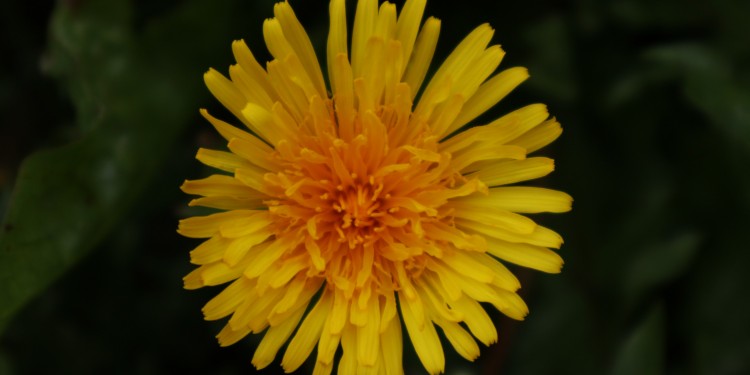
Why does dandelion never fall ill?
Plants possess enzymes called polyphenoloxidases, which can oxidize certain chemical compounds and thus produce the typical brown colour that we know, for example, from freshly cut apples. Animals and humans also possess similar enzymes, the tyrosinases. However, they can also oxidize other compounds and thus perhaps produce more antimicrobial substances.
Researchers at the University of Münster have now discovered that the dandelion has an unusually large gene family of polyphenoloxidases – four of which are actually tyrosinases. These enzymes, which are unusual for plants, could be partly responsible for the fact that dandelions hardly ever fall ill.
Biologist Prof. Dr. Bruno Moerschbacher led the study published in the journal "Angewandte Chemie" and reported on the new findings in a guest article.
Dandelion – everyone knows it, gourmets love it, gardeners hate it. And biologists are intrigued. Dandelion is one of the very rare plants that almost never fall ill. But why? If we knew this, we might be able to protect our roses from rust, our potatoes from late blight, and our wine from mildew. Dandelion is a latex producing plant and we remember from childhood that we were always told: dandelion latex is toxic (which is true though most of the times, no more than a little belly ache ensues).
Maybe the latex is protecting dandelion from pathogens? It has long been known that besides the wellknown bitter compounds, latex also contains an enzyme which is a polyphenoloxidase. Polyphenoloxidases are common to many plants, they oxidize diphenolics in the presence of oxygen, and the resulting quinones are “toxic” – one may also say: they are antimicrobial – because they are highly reactive: They react with other biomolecules, inactivating them. However, the quinones also react with themselves, yielding a brown polymer (a giant molecule) – in sort of a detoxification reaction protecting the plant from its own toxic compounds. We know this browning reaction not only from dandelion, but also from apples and bananas which turn brown quickly on air, protecting wounds from penetrating pathogens.
Animals and humans have similar enzymes, resembling polyphenoloxidases. Here, these enzymes are involved in melanin biosynthesis, i.e. equally yielding a brown pigment, for instance in our hair and skin. These enzymes are called tyrosinases. Animals and humans with a mutation in the tyrosinase gene are albinos. But there is an important difference between animal tyrosinases and plant polyphenoloxidases – or so it was thought.
Tyrosinases can oxidise monophenolics to yield diphenolics, and the latter again to yield quinones, while plant enzymes catalyse only the second of these reactions. Why? This has long been unknown. About a year ago, scientists postulated to have found the crucial difference: two specific amino acids, an asparagine and a glutamic acid close to the catalytic site of the enzyme, were claimed to be necessary and sufficient for tyrosinase activity. And plant enzymes were supposed to lack these two amino acids: if they were introduced using molecular genetics, even plant polyphenoloxidases were said to be able to oxidise monophenolics.
The distinctiveness of dandelion
But low and behold, this was argued without considering dandelion. We were now able to show that it is not as simple as that: dandelion contains a whole family of polyphenoloxidase genes, eleven different genes, eleven different enzymes! Some of these are typical polyphenoloxidases which can only catalyse the second reaction, but others are in truth tyrosinases which can also catalyse the first reaction. And this is not at all related to the presence or absence of these two amino acids.
There had also been an older, alternative hypothesis according to which a phenylalanine in plant enzymes was supposed to hinder the oxidation of monophenolics, but this hypothesis, too, was disproved by the dandelion enzymes. What then is the reason? We do not know. But we were able to come up with new hypotheses which in their turn can now be tested.
And should the diversity of these enzymes in dandelion, or their unusual ability to oxidise monophenolics, be responsible for its resistance to disease? This also, we do not know. But already years ago, we were able to show that one of these enzymes, PPO-2, is involved in disease resistance: if we knock out this gene, the plant falls ill more easily. And PPO-2 – as we now know – is in truth a tyrosinase. And likewise three other dandelion PPOs, among them PPO-1, the enzyme from latex. Look, a new hypothesis is about to form – back to the lab bench!
Funding:
This research was supported by a doctoral fellowship awarded by the “Deutsche Bundesstiftung Umwelt” to Dr. Sarah Prexler.
Original publication:
S. M. Prexler et al. (2019): Catechol Oxidase versus Tyrosinase Classification Revisited by Site-Directed Mutagenesis Studies. Angewandte Chemie; DOI: 10.1002/anie.201902846
